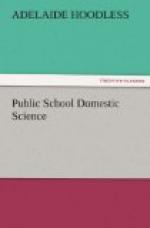-+--------
-------------------------+-----------------------------
------------- | In Dry Matter +------+------+--------+---------+--------- | | | | | Nitrogen | Ash. | Fat. | Fibre. | Protein.| free | | | | | extract. -------------------------+------+------+--------+---------+-
-------- |P.ct. |P.ct. | P.ct. | P.ct. | P.ct. Bread from whole winter | | | | | wheat | 2.40 | 1.25 | 2.95 | 16.20 | 77.20 Bread from whole spring | | | | | wheat | 1.82 | 1.34 | 3.02 | 16.49 | 77.33 Bread from fine flour, | | | | | winter wheat | .66 | .35 | .49 | 13.33 | 85.17 Bread from fine flour, | | | | | spring wheat | .47 | .51 | .42 | 15.66 | 82.94 Corn bread from whole | | | | | maize | 1.95 | 4.29 | 2.62 | 13.33 | 77.81 -------------------------+------+------+--------+---------+-
--------
BREAD.
The most valuable food product manufactured from flour is bread.
Bread contains so many of the ingredients required to nourish the body, viz.: fat, proteid, salts, sugar and starch, that it may well be termed the “staff of life.” As it does not contain enough fat for a perfect food the addition of butter to it renders it more valuable as an article of diet. Mrs. Ellen H. Richards gives the following explanation of what constitutes ideal bread: “(1) It should retain as much as possible of the nutritive principles of the grain from which it is made; (2) it should be prepared in such a manner as to secure the complete assimilation of these nutritive principles; (3) it should be light and porous, so as to allow the digestive juices to penetrate it quickly and thoroughly; (4) it should be nearly or quite free from coarse bran, which causes too rapid muscular action to allow of complete digestion. This effect is also produced when the bread is sour.” Bread is made from a combination of flour, liquid (either milk or water), and a vegetable ferment called yeast (see yeast recipes). The yeast acts slowly or rapidly according to the temperature to which it is exposed. The starch has to be changed by the ferment called diastase (diastase is a vegetable ferment which converts starchy foods into a soluble material called maltose) into sugar, and the sugar into alcohol and carbonic acid gas (carbon dioxide), when it makes itself known by




